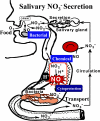Dynamic aspect of reactive oxygen and nitric oxide in oral cavity
- PMID: 18231624
- PMCID: PMC2212350
- DOI: 10.3164/jcbn.2008002
Dynamic aspect of reactive oxygen and nitric oxide in oral cavity
Abstract
Oral mucosa is a critical protective interface between external and internal environments. Therefore, it must serve as a barrier to a huge number of microbial species present in the environment. Saliva is an important factor that provides for the environment in the oral cavity, and it is indispensable to the host defense reaction in this manner. Oral neutrophils are also important contributors to maintaining the balance between health and disease in this complex environment. These produce reactive oxygen species, nitric oxide, and several antimicrobial peptides, and enzymes. Neutrophils and saliva all contribute to the maintaining the health of the oral cavity in overlapping but independent ways. In addition to production by neutrophils and macrophage, some bacteria can also generate superoxide, hydrogen peroxide, and nitric oxide. Dietary intake of nitrate-enriched vegetables might play important roles in the protection of the oral and stomach against hazardous pathogens via the gastro-intestinal-salivary cycle of nitric oxide (NO) and related metabolites. This review will focus on defense system of the human oral cavity and metabolism of reactive oxygen and NO.
Keywords: bacteria; neutrophils; nitric oxide; oral cavity; superoxide.
Figures
Similar articles
-
[Nitrate: a pioneer from the mouth to the systemic health and diseases].Zhonghua Kou Qiang Yi Xue Za Zhi. 2020 Jul 9;55(7):433-438. doi: 10.3760/cma.j.cn112144-20200410-00204. Zhonghua Kou Qiang Yi Xue Za Zhi. 2020. PMID: 32634879 Chinese.
-
Salivary nitrite production is elevated in individuals with a higher abundance of oral nitrate-reducing bacteria.Free Radic Biol Med. 2018 May 20;120:80-88. doi: 10.1016/j.freeradbiomed.2018.03.023. Epub 2018 Mar 14. Free Radic Biol Med. 2018. PMID: 29550328
-
Detection of nitric oxide and its derivatives in human mixed saliva and acidified saliva.Methods Enzymol. 2008;440:381-96. doi: 10.1016/S0076-6879(07)00824-5. Methods Enzymol. 2008. PMID: 18423231 Review.
-
The oral microbiome and nitric oxide homoeostasis.Oral Dis. 2015 Jan;21(1):7-16. doi: 10.1111/odi.12157. Epub 2013 Jul 10. Oral Dis. 2015. PMID: 23837897 Review.
-
[The influence of alcohol on the oral cavity, salivary glands and saliva].Pol Merkur Lekarski. 2011 Jan;30(175):69-74. Pol Merkur Lekarski. 2011. PMID: 21542250 Review. Polish.
Cited by
-
Endogenous Intoxication and Saliva Lipid Peroxidation in Patients with Lung Cancer.Diagnostics (Basel). 2016 Nov 16;6(4):39. doi: 10.3390/diagnostics6040039. Diagnostics (Basel). 2016. PMID: 27854319 Free PMC article.
-
Role of hydrogen generation by Klebsiella pneumoniae in the oral cavity.J Microbiol. 2010 Dec;48(6):778-83. doi: 10.1007/s12275-010-0149-z. Epub 2011 Jan 9. J Microbiol. 2010. PMID: 21221934
-
«Salivaomics» of Different Molecular Biological Subtypes of Breast Cancer.Curr Issues Mol Biol. 2022 Jul 5;44(7):3053-3074. doi: 10.3390/cimb44070211. Curr Issues Mol Biol. 2022. PMID: 35877435 Free PMC article.
-
Regulation of nitric oxide production in health and disease.Curr Opin Clin Nutr Metab Care. 2010 Jan;13(1):97-104. doi: 10.1097/MCO.0b013e328332f99d. Curr Opin Clin Nutr Metab Care. 2010. PMID: 19841582 Free PMC article. Review.
-
Biochemical Markers of Saliva in Lung Cancer: Diagnostic and Prognostic Perspectives.Diagnostics (Basel). 2020 Mar 27;10(4):186. doi: 10.3390/diagnostics10040186. Diagnostics (Basel). 2020. PMID: 32230883 Free PMC article.
References
-
- Tabak L.A., Levine M.J., Mandel I.D., Ellison S.A. Role of salivary mucins in the protection of the oral cavity. J. Oral Pathol. 1982;11:1–17. - PubMed
-
- Slomiany B.L., Murty V.L., Piotrowski J., Slomiany A. Salivary mucins in oral mucosal defense. Gen. Pharmacol. 1996;27:761–771. - PubMed
-
- Grisham M.B., Ryan E.M. Cytotoxic properties of salivary oxidants. Am. J. Physiol. 1990;258:C115–121. - PubMed
-
- McArthur W.P., Clark W.B. Specific antibodies and their potential role in periodontal diseases. J. Periodontol. 1993;64:807–818. - PubMed
LinkOut - more resources
Full Text Sources
Other Literature Sources




